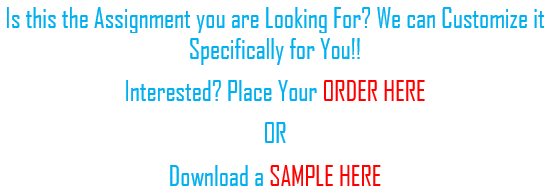Journal Entry (2–3 pages):
- Explain what most excited and/or concerned you throughout your pediatric clinical experience.
- Discuss how your personal definition of family and family roles has changed or stayed the same.
- How has your understanding of family and family roles influenced your assessment of children and their families?
- Explain how your understanding of culture (both the culture of the provider and that of the child and his or her family) has changed and how it may have influenced the assessments you conducted during your practicum.
- Assess how you did with accomplishing the goals and objectives you developed in Week 1 for the practicum experience.
- Based on your practicum experience, refine your existing goals and/or develop new goals for your continued education and professional practice. Be sure to consider the NAPNAP Position Statement on Age Parameters for Pediatric Nurse Practitioner Practice.
- Use title page and references according to APA.
Title: Reflective Journal: Pediatric Clinical Experience
Introduction: Throughout my pediatric clinical experience, I encountered a multitude of emotions, challenges, and learning opportunities. This reflective journal delves into what excited and concerned me during this period, how my perception of family and culture evolved, and evaluates my progress in achieving set goals. Additionally, it outlines refined and new goals for my continued education and professional practice in alignment with the NAPNAP Position Statement on Age Parameters for Pediatric Nurse Practitioner Practice.
Excitement and Concerns: The aspect that excited me the most during my pediatric clinical experience was witnessing the resilience and optimism displayed by the children and their families in the face of illness or adversity. Their strength and determination to overcome obstacles were truly inspiring. However, this experience also brought forth concerns, particularly regarding the disparities in healthcare access and the impact of socio-economic factors on child health outcomes. Witnessing children facing barriers to adequate healthcare due to financial constraints or lack of resources highlighted the urgent need for systemic changes to address these disparities.
Evolution of Family Definition and Roles: My personal definition of family has evolved significantly throughout this clinical experience. Initially, I viewed family in a traditional sense, consisting of biological parents and their children. However, I now recognize that family extends beyond biological ties and can encompass various configurations, including single-parent households, adoptive families, and chosen families. Furthermore, my understanding of family roles has become more fluid, acknowledging that individuals within a family unit may assume diverse roles based on their strengths, circumstances, and cultural norms.
Impact on Assessment of Children and Families: Understanding the complexities of family dynamics and cultural influences has enhanced my assessment approach during interactions with children and their families. Recognizing the diversity within families, I strive to adopt a culturally sensitive and inclusive approach, ensuring that assessments consider the unique backgrounds, values, and beliefs of each family. This holistic perspective enables me to better understand the context in which children thrive or face challenges, facilitating more comprehensive and personalized care plans.
Evolution of Cultural Understanding: My understanding of culture, both from the perspective of the provider and that of the child and their family, has deepened significantly. Engaging with families from diverse cultural backgrounds has highlighted the importance of cultural humility and ongoing self-reflection to recognize and address implicit biases. Moreover, understanding cultural norms and practices has influenced my assessments by guiding me to ask culturally relevant questions and tailor interventions accordingly. This cultural competency is vital for providing culturally responsive care that respects the values and preferences of each family.
Assessment of Goals and Objectives: Reflecting on the goals and objectives set at the beginning of the practicum, I believe I have made significant progress in achieving them. These included improving clinical assessment skills, enhancing communication with pediatric patients and their families, and developing cultural competence. Through hands-on experience, mentorship, and self-directed learning, I have strengthened my clinical acumen and communication abilities, while also deepening my understanding of cultural factors influencing pediatric care.
Refined and New Goals: Building on the foundation laid during the practicum experience, I have refined and developed new goals for my continued education and professional practice. These include:
- Further enhancing clinical proficiency in pediatric assessment and diagnosis through continued education, skill-building workshops, and case-based learning.
- Strengthening cultural competence by actively seeking opportunities for cross-cultural immersion, engaging in diversity training, and fostering ongoing dialogue with colleagues and mentors.
- Advocating for health equity and addressing healthcare disparities by actively participating in community outreach programs, supporting policy initiatives, and promoting inclusive healthcare practices.
- Continuously reassessing and refining my practice to align with the NAPNAP Position Statement on Age Parameters for Pediatric Nurse Practitioner Practice, ensuring that care delivery is evidence-based, age-appropriate, and meets the unique needs of pediatric patients.
In conclusion, my pediatric clinical experience has been transformative, shaping my understanding of family dynamics, cultural influences, and healthcare disparities. Moving forward, I am committed to continuous growth, advocating for equitable care, and providing compassionate, culturally responsive services to pediatric patients and their families.

